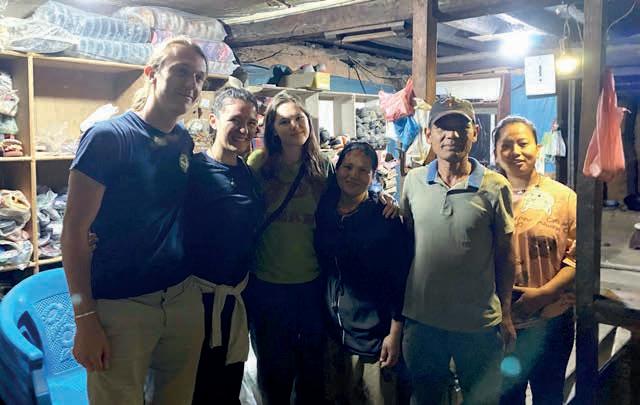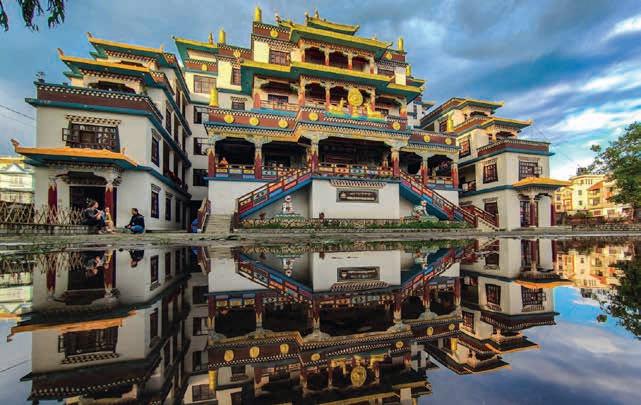
5 minute read
A life-changing perspective; teaching in Nepal Pia Middleton StM’21
A life-changing perspective; teaching in Nepal
With some of my students in Nishanke
Advertisement
Part of my decision to have a year’s break from education was to experience cultures and lifestyles different from my own, and to help communities that may not be as privileged as the ones I have grown up in. So, in March 2022, I raised some of my own funding and, along with a gratefully received bursary from the
Worth Society’s Global Action Award Scheme, joined Love
Volunteers and Volunteers Initiative Nepal in the hope that my help could have a positive impact on people in need.
Love Volunteers was started in 2009 by a brother and sister, aiming to lower fees paid to participate in charity work, and to make it more accessible and less unusual to do voluntary work abroad. They have many different programs, in many different countries, such as environmental conservation and women’s empowerment. When I got to Nepal, the organisation I worked with was Volunteers Initiative Nepal (VIN) which is a nonprofit, non-governmental charity aiming to empower marginalised communities through 'equitable, inclusive and holistic development programs’. They also offer a number of different programs around Nepal such as child development and medical care.
I met some amazing people through VIN, and felt well supported through my volunteer process, but also had my own sense of freedom, such as being able to create my own curriculum. When I landed, my first few days were spent in Kathmandu at the volunteer hostel for VIN and were focused on orientation - such as significant cultural information and local customs. The purpose of my visit was mainly to work in a Buddhist monastery teaching English to the younger monks but, after consulting with the head of VIN, I was given the choice to split my time into where my voluntary work would be more appreciated and needed. So I began by spending time teaching in a village in eastern Nepal called Nishanke.
I was shocked by how rural the village was - the nearest town was a three hour walk! A few of us volunteers were sent with supplies (such as apples and bread since they aren’t available to buy in remote places) by car to Nishanke, which took us ten hours from Kathmandu. On our first day the village was holding a ‘Women’s Celebration Talk’ where all the women from neighbouring villages come together to dance, cook, talk and laugh together. We were invited to join in, being shown how to dance properly by the older women and eventually we were gifted with flower wreaths. It was such an immersive experience and a great way to get to know the local people.

Tara’s house - a small kitchenette out of frame and her bed is just behind us! Khawalung Tashi Chloeling Monastery

Every day I taught four English classes to a wide variety of students - the youngest aged 10, and the oldest aged 45. I was blown away by the passion to learn; everyone I met was so enthusiastic, which made teaching such a joy for me. After a week or so, I started to become friends with some of my students, who would stay behind after class to ask me questions and talk to me as well as the other volunteers. Our housing building was an open house for everyone, so often we ate dinner with our students. One woman I taught, Tara, couldn’t speak much English and yet still invited me and the other volunteers to her house for tea with buffalo milk almost every day - and for dinner on some occasions. We got to know her and her family quite well - it was so touching how little they had and how much they gave to us. When we left we gave Tara all of our medicines (paracetamol, penicillin, etc) as she was a nurse, which made her cry. A small act for us had such a big impact on her.
I very much valued the authentic and involved experience I had, really getting to know the community I was helping - and seeing the daily impact. Not only was I able to teach my language, but I learnt too. Ramesh, a local cook, taught us all how to make samosas. Sunita, a student of mine, taught me how to say basic sentences in Nepali, and Sirjana, a women’s coordinator, taught me the meaning of every single Tika.
After Nishanke, we drove back to Kathmandu where I said goodbye to the other volunteers and went to Khawalung Tashi Chloeling, a Buddhist monastery situated in the north east of Kathmandu with monks as young as 6! I taught in the morning and would spend the afternoons getting to know the children, learning as much about them and their way of living as possible. The monks had so much energy and a better understanding of English already, so I had more freedom in what I taught. We all ate together (dal bhatt for breakfast, lunch and dinner) in silence, and I would wake up at 5am to join in on the meditation and prayer sessions.
I learnt so much from the monks, not just about the religion but about their culture too. I went to visit stupas (Buddhist shrines) with them, including The Bouddhanath Stupa, the biggest in Nepal! Again, this experience was so authentic and engaging I felt so lucky to have been living alongside the monks I was teaching and to be so immersed into their community. The youngest monks were so interested in learning not just English but everything I could tell them about western culture. They were fascinated by music, telling me their favourite was Eminem (who they listened to on the radio) and by my cameras.
The whole experience was so different to anything I had known before. The opportunity changed my perspective on life and made me so grateful for the chance to help these communities in such a personal way. I will never forget the people I met, and all of their stories. I wouldn’t have seen the country, and got to know it as I did, and become involved in the local way of life without volunteering - so I would urge any gap year students thinking of voluntary work to apply for a Global Action Award!
Pia Middleton StM’21










